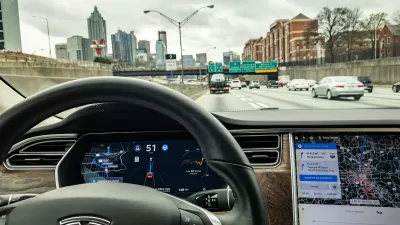The headline chosen here summarizes the argument put forward by Vox's Joseph Stromberg, who believes that self-driving cars will be a serious upgrade over the average human driver.
Joseph Stromberg writes an article supporting a claim that self-driving cars will provide enormous safety benefits to cyclists and pedestrians, citing the example of a biker who encountered a self-driving car in an intersection and did a track stand (an expert move that allows the cyclist to stand in place on the bike). The self-driving car barely moved as it tried to interpret the cyclist's small movements. Writes Stromberg:
"It's tempting to interpret all this as a sign of the steep learning curve Google's cars will encounter as they drive more in the complex conditions of the real world. But I think it shows something quite different.
Engineers will probably be able to teach the cars to distinguish between track stands and real movement fairly easily. But the cars will continue to drive with extreme caution and sensitivity, which is absolutely great news for cyclists and pedestrians."
Stromberg goes on to note that so far, experiments with self-driving cars have had the unintended consequence of providing evidence of the failures of human drivers. "As another Google post detailed, its cars frequently spot people driving on the wrong side of the road, dangerously turning across several lanes of traffic, and proceeding through intersections when there are still cars or cyclists in them. Human drivers zone out, miss cars in their blind spots, and often fail to spot bikes and pedestrians. This is part of why more than 30,000 people die in traffic crashes in the US each year," according to Stromberg.
FULL STORY: Why Google's self-driving cars will be great for cyclists and pedestrians

Alabama: Trump Terminates Settlements for Black Communities Harmed By Raw Sewage
Trump deemed the landmark civil rights agreement “illegal DEI and environmental justice policy.”

Planetizen Federal Action Tracker
A weekly monitor of how Trump’s orders and actions are impacting planners and planning in America.

The 120 Year Old Tiny Home Villages That Sheltered San Francisco’s Earthquake Refugees
More than a century ago, San Francisco mobilized to house thousands of residents displaced by the 1906 earthquake. Could their strategy offer a model for the present?

In Both Crashes and Crime, Public Transportation is Far Safer than Driving
Contrary to popular assumptions, public transportation has far lower crash and crime rates than automobile travel. For safer communities, improve and encourage transit travel.

Report: Zoning Reforms Should Complement Nashville’s Ambitious Transit Plan
Without reform, restrictive zoning codes will limit the impact of the city’s planned transit expansion and could exclude some of the residents who depend on transit the most.

Judge Orders Release of Frozen IRA, IIJA Funding
The decision is a victory for environmental groups who charged that freezing funds for critical infrastructure and disaster response programs caused “real and irreparable harm” to communities.
Urban Design for Planners 1: Software Tools
This six-course series explores essential urban design concepts using open source software and equips planners with the tools they need to participate fully in the urban design process.
Planning for Universal Design
Learn the tools for implementing Universal Design in planning regulations.
Clanton & Associates, Inc.
Jessamine County Fiscal Court
Institute for Housing and Urban Development Studies (IHS)
City of Grandview
Harvard GSD Executive Education
Toledo-Lucas County Plan Commissions
Salt Lake City
NYU Wagner Graduate School of Public Service





























